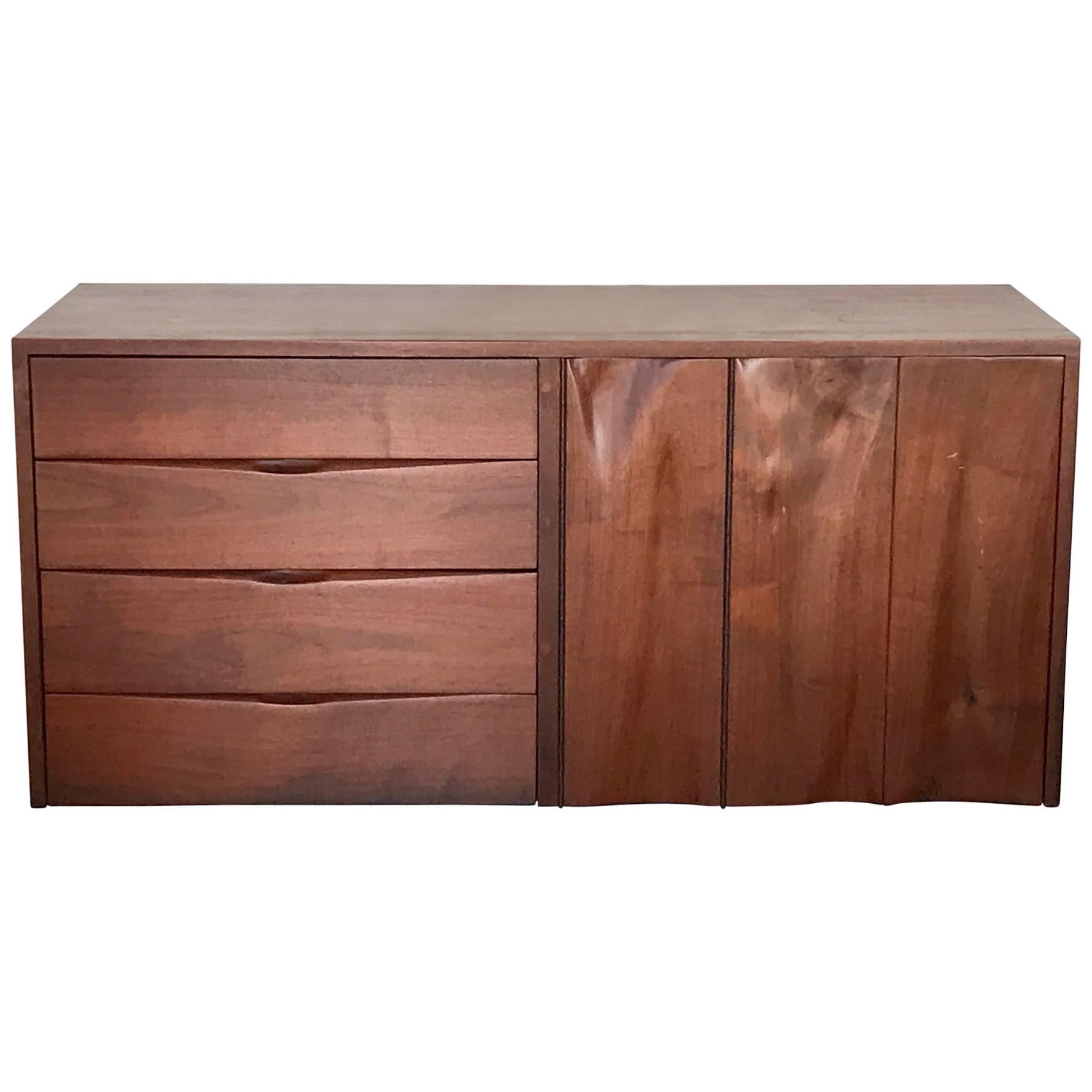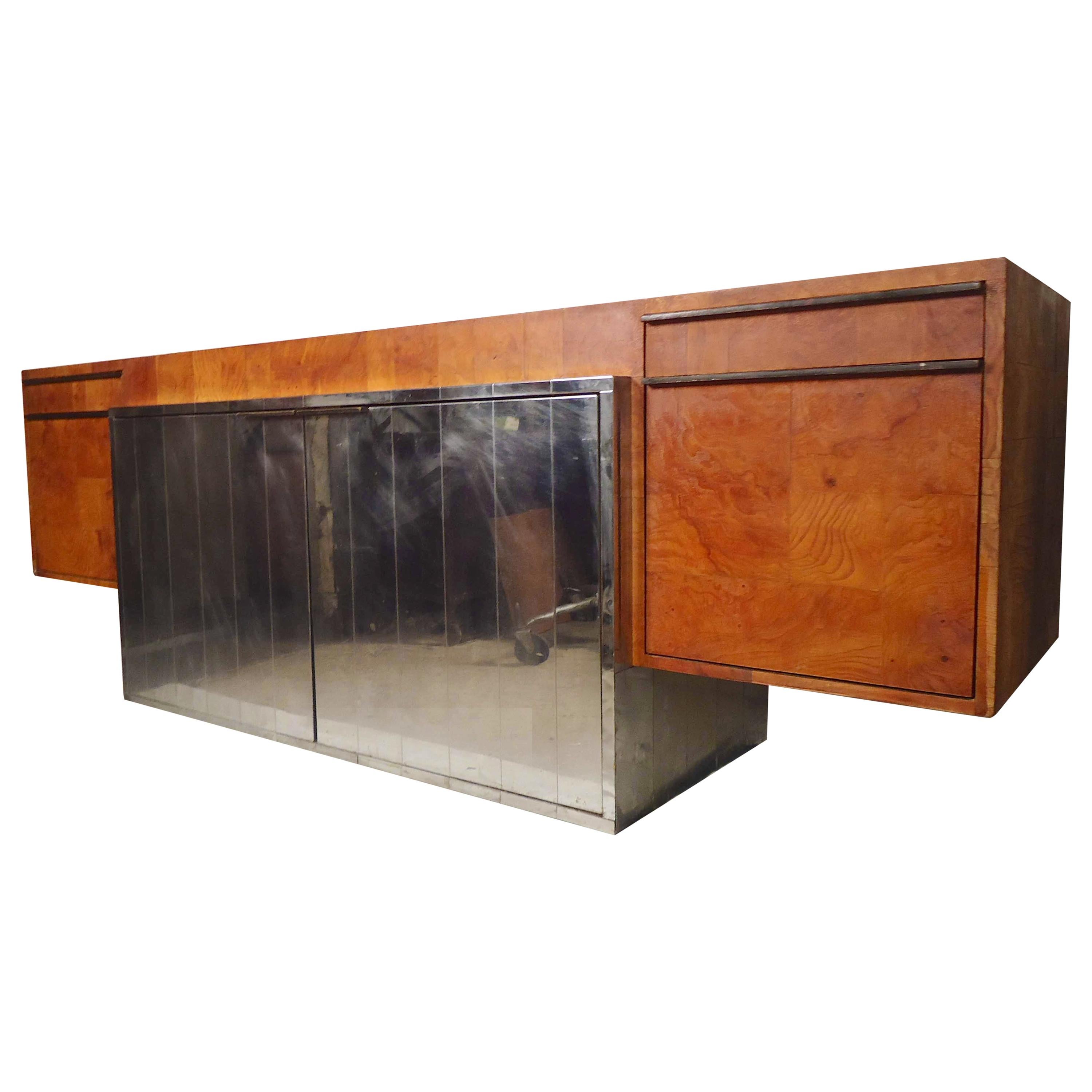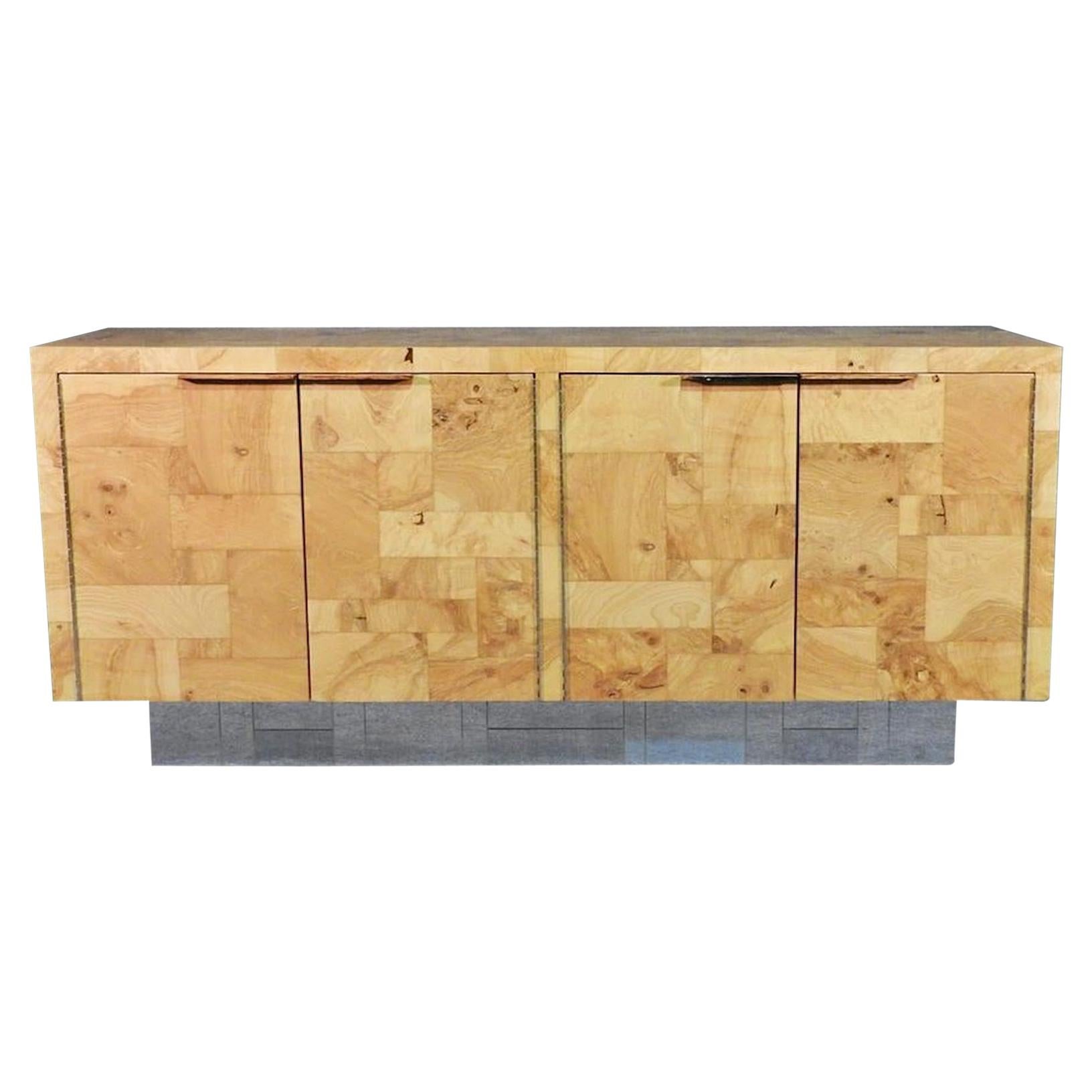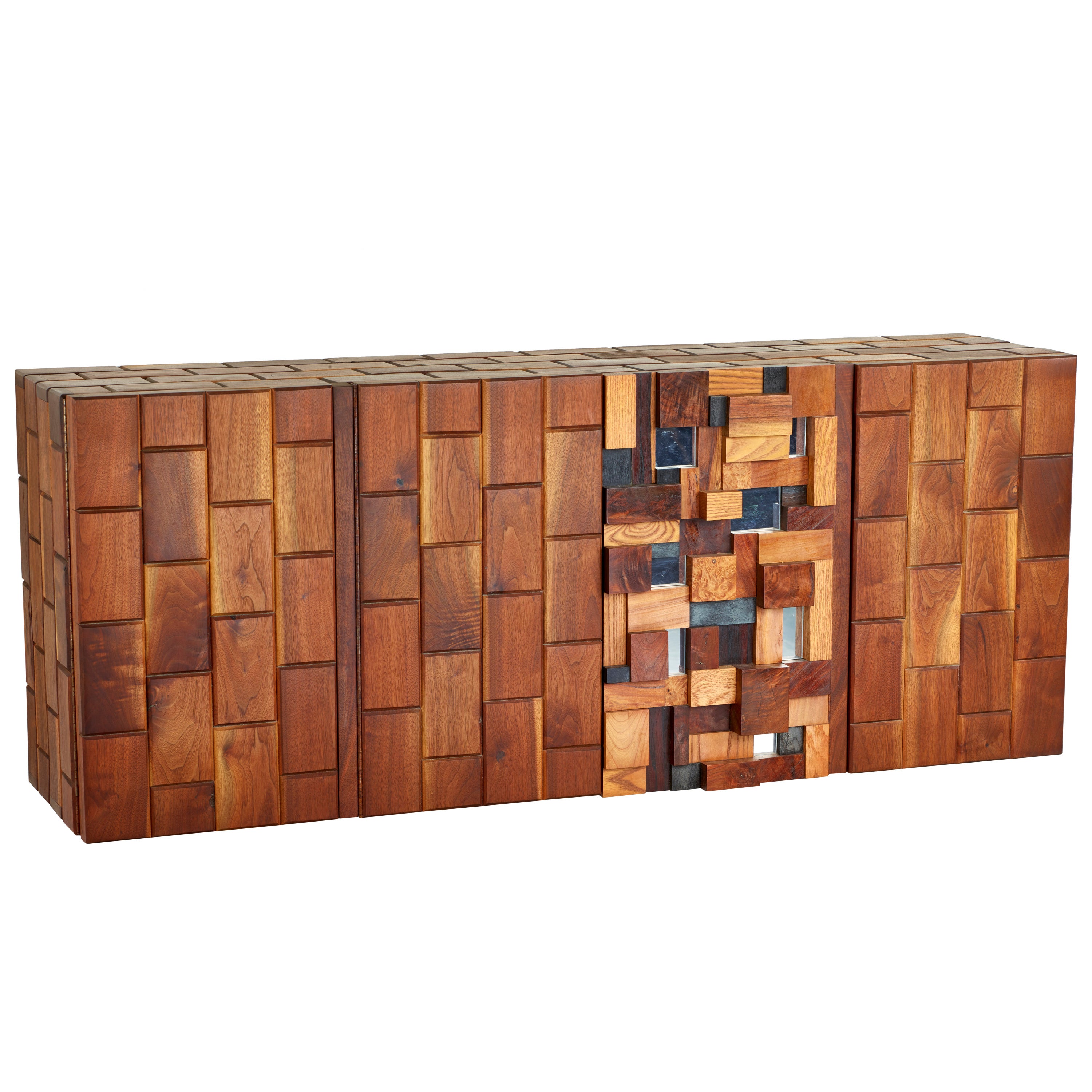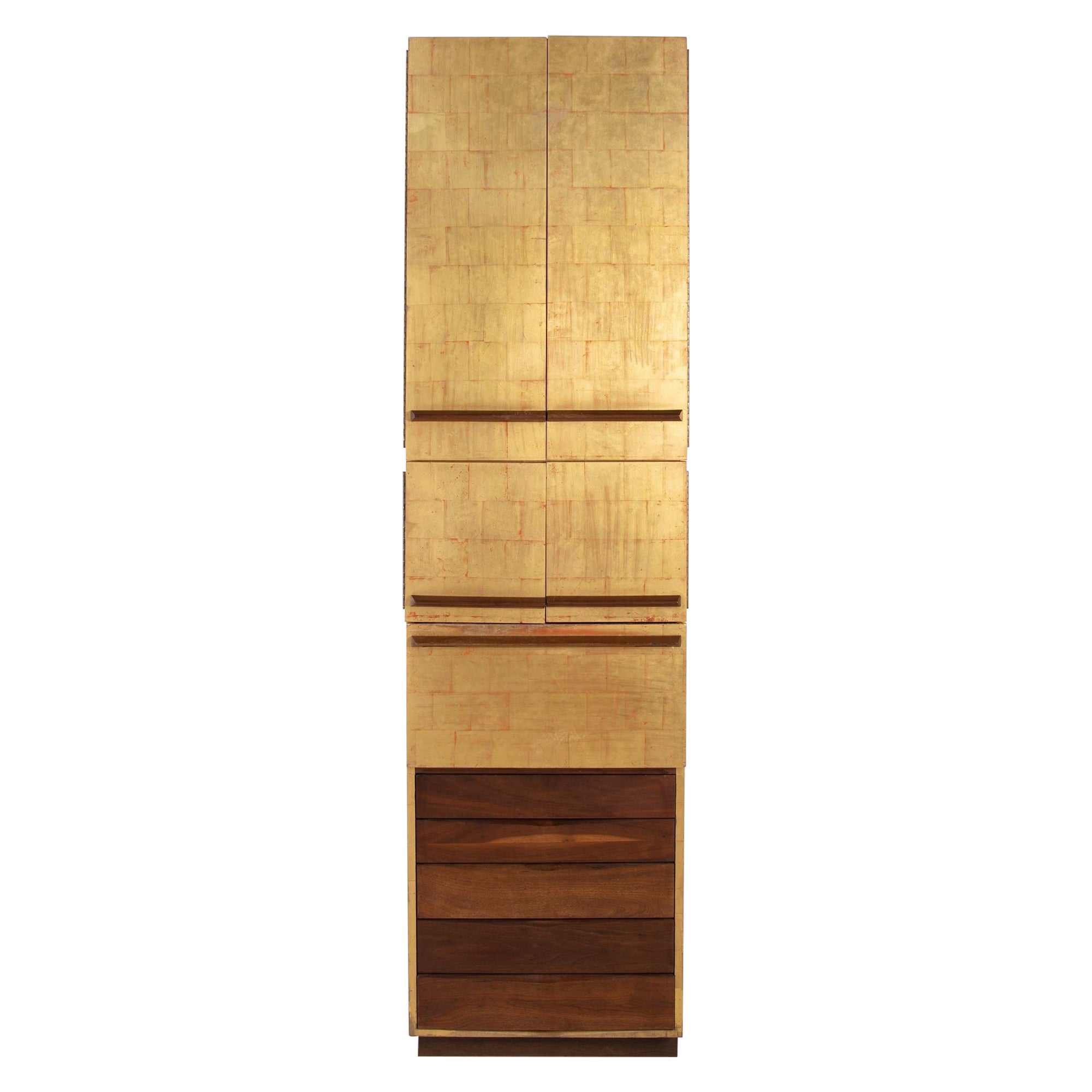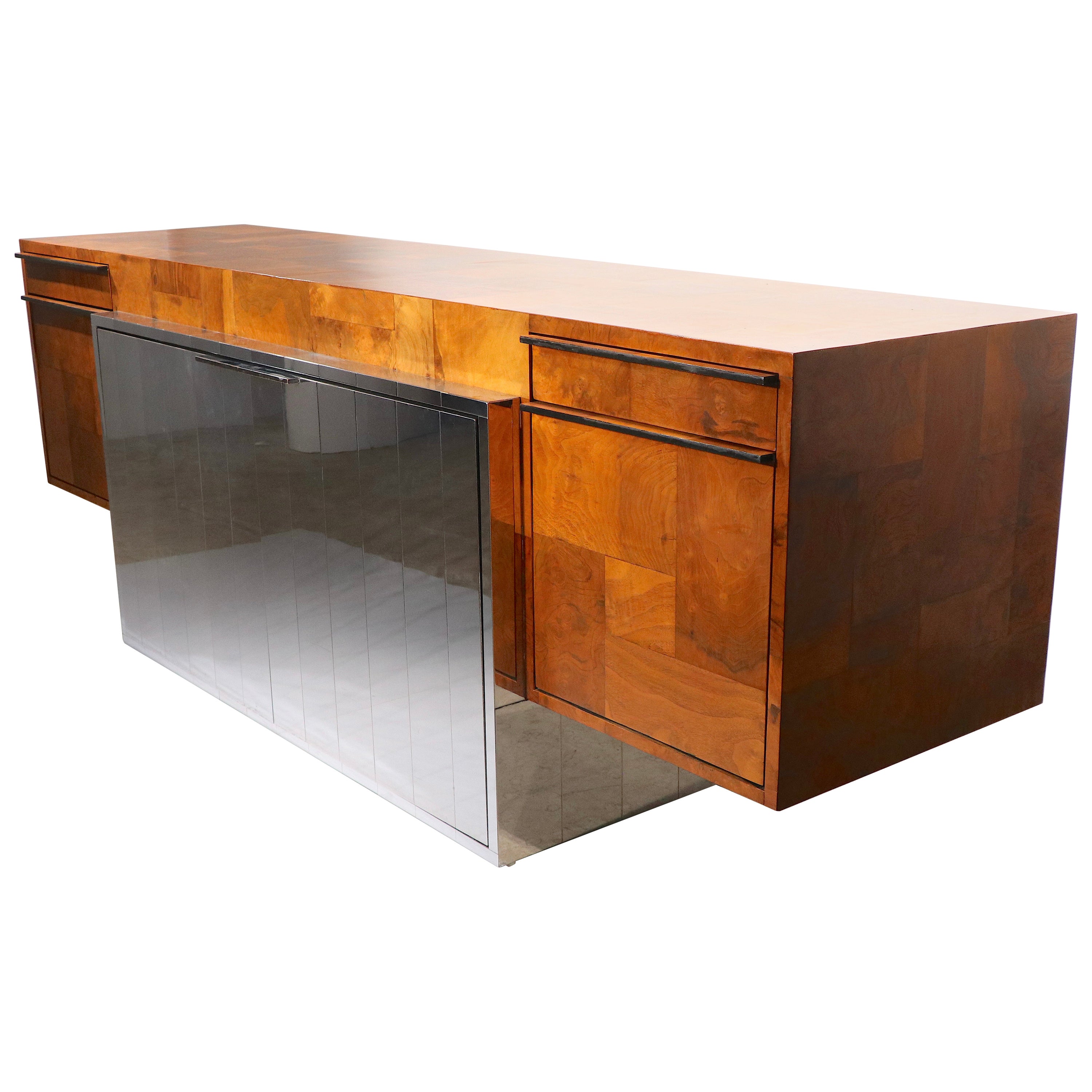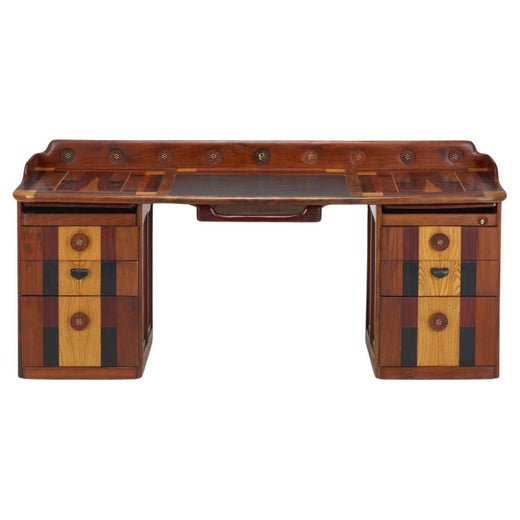Cabinet Credenza Phillip Lloyd Powell and Paul Evans
About the Item
- Creator:Phillip Lloyd Powell (Designer),Paul Evans (Designer)
- Dimensions:Height: 34.25 in (87 cm)Width: 84.5 in (214.63 cm)Depth: 20.25 in (51.44 cm)
- Style:Mid-Century Modern (Of the Period)
- Materials and Techniques:
- Place of Origin:
- Period:
- Date of Manufacture:1960s
- Condition:Wear consistent with age and use. Fine with minor wear commensurate with age. Beautiful mellow aged patina. The open carved side doors were originally for speakers and black boards are currently present behind (not permanently fixed). The base is from later and has some veneer chips.
- Seller Location:Atlanta, GA
- Reference Number:1stDibs: LU9450935222
Phillip Lloyd Powell
An American woodworker known for a wide range of furniture that is sensuous, sculptural and imbued with character, Phillip Lloyd Powell is an iconic figure in design. His organic style transcended the conventions of popular mid-century modern furniture and is best reflected in the vintage cabinets and tables for which he is renowned.
“I am an artist working with furniture,” Powell once said. But the self-taught furniture maker wore a number of different hats throughout his lifetime. He crafted handmade furniture as a teenager at his boyhood home and went on to study engineering at what is now Drexel University. Powell served in the Army Air Corps during World War II, and, on his return, he established his first showroom in New Hope, in his home state of Pennsylvania, stocking furniture from Knoll, Herman Miller and Isamu Noguchi.
In New Hope, Powell encountered fellow furniture designers Paul Evans and George Nakashima. The latter, a master woodworker who preferred a personal approach to design over industrial methods and materials, encouraged Powell to concentrate on making his own furniture. When Powell did so, he’d experiment with Nakashima’s unused stock of wood, drawing on natural world forms for seating and shapely coffee tables.
Evans, who moved to New Hope in 1955, was invited to share Powell’s studio space. Powell’s furniture design practice really took off and a collaboration with Evans put into motion the 1960s American Studio Craft Movement, which came to include furniture designers Wharton Esherick and Sam Maloof. The decade-long partnership between Evans and Powell yielded stone-topped tables, walnut chests with sculptured metal exteriors and more.
Powell was inspired by Evans’s artistry as a jewelry designer — he was a skilled welder whose Cityscape pieces are milestones of brutalism. Powell, in turn, encouraged him to turn his sculptures into furniture. Like Evans, Powell incorporated a range of materials into his work, rendering the interiors of his hand-carved cabinets alluring and distinctive with applications of silver leaf and fabrics.
The sinewy arms of Powell’s famous New Hope lounge chair are representative of his broad expertise with wood and his ability to make graceful yet functional furniture. He worked slowly, and the influence of the natural world remained a driving force in his designs. Powell produced approximately 1,000 pieces while he lived and worked in New Hope until his death in 2008.
Find vintage Phillip Lloyd Powell furniture on 1stDibs.
Paul Evans
A designer and sculptor, Paul Evans was a wild card of late 20th century modernism. A leading light of the American Studio Furniture movement, Evans’s sideboards, credenzas, coffee tables and other work manifests a singular aesthetic sense, as well as a seemingly contradictory appreciation for both folk art forms and for new materials and technologies.
Evans’s primary material was metal, not wood, which was favored by his fellow studio designers, and Bucks County, Pennsylvania, neighbors George Nakashima and Phillip Lloyd Powell. He trained in metallurgy and studied at the Cranbrook Academy of Art, the famed crucible of modern design and art in suburban Detroit. For a time early in his career, Evans also worked at Sturbridge Village, a historical “living museum” in Massachusetts, where he gave demonstrations as a costumed silversmith.
Evans’s earliest work unites these influences. The pieces that made his reputation are known as “sculpted-front” cabinets: wood cases faced with box-like high-relief patinated steel mounts laid out in a grid pattern. Each mount contains a metal emblem, or glyph, and the effect is that of a brawny quilt.
Evans’s later work falls into three distinct style groups. His sculpted-bronze pieces, begun in the mid-1960s, show Evans at his most expressive. He employed a technique in which resin is hand-shaped, and later sprayed with a metal coating, allowing for artistic nuance in the making of chairs, tables and case pieces. Later in the decade and into the 1970s, Evans produced his Argente series for celebrated manufacturer Directional (a brand known to vintage mid-century modern furniture collectors everywhere): consoles and other furniture forms that feature aluminum and pigment-infused metal surfaces welded into abstract organic forms and patterns.
Last, Evans's Cityscape design series — a milestone in the history of brutalist design — meshed perfectly with the sleek, “high tech” sensibility of the later ’70s. Evans constructed boxy forms and faced them with irregular mosaic patterns that mixed rectangular plaques of chromed steel, bronze or burlwood veneer. These, like all of Paul Evans’s designs, are both useful and eye-catching. But their appeal has another, more visceral quality: these pieces have clearly been touched by an artist’s hand.
Find a collection of authentic Paul Evans furniture today on 1stDibs.
- ShippingRetrieving quote...Ships From: Atlanta, GA
- Return PolicyA return for this item may be initiated within 2 days of delivery.
- Rare and Early Walnut Wall Hanging Cabinet by Paul Evans and Phillip PowellBy Paul EvansLocated in Atlanta, GAAn early wall hanging walnut cabinet crafted in collaboration between Paul Evans (1931 - 1987) and Phillip Lloyd Powell (1919 - 2008) when they ...Category
Vintage 1960s American Mid-Century Modern Cabinets
MaterialsMetal
- Studio Walnut Desk by Phillip Lloyd PowellBy Phillip Lloyd PowellLocated in Atlanta, GAStunning desk with drawers and compartment in walnut by Phillip Lloyd Powell (1919-2008). The freeform surface is made of thick walnut plank with a patched joined design with two ros...Category
Vintage 1960s American Mid-Century Modern Desks and Writing Tables
MaterialsWalnut
- Paul Frankl Sideboard with Lacquered Cork and BrassBy Paul FranklLocated in Atlanta, GALarge and impressive sideboard or credenza piece by Paul Frankl for Johnson Furniture Co, USA, dated 1940s, in the taste of American Art Deco transitioning into Modern. The main construction is mahogany, with center door of lacquered cork...Category
Vintage 1940s American Modern Credenzas
MaterialsBrass
- Pair of Carved Wood Doors by Phillip PowellBy Phillip Lloyd PowellLocated in Atlanta, GAThese two doors were commissioned directly from the artist and were made for a specific site . The front of the doors are wonderfully contoured and are highly sculptural. The design ...Category
Vintage 1960s American Mid-Century Modern Doors and Gates
MaterialsMirror, Walnut, Giltwood, Lacquer
- Walnut Sideboard with Top Shelf by George NakashimaBy George NakashimaLocated in Atlanta, GAA two-piece custom sideboard pr credenza handcrafted by George Nakashima, circa 1969 in his new hope studio. It is constructed with American black walnut with solid oak interiors. Th...Category
Vintage 1960s American Mid-Century Modern Sideboards
MaterialsWalnut, Oak
- Two Walnut Table Studio Made By Phillip Llyod PowellBy Phillip Lloyd PowellLocated in Atlanta, GAA near pair of sculpted tripod triangular tables in American Walnut studio crafted by Phil Powell in his New Hope Studio. The table tops are supported by spindle and tapered legs an...Category
Vintage 1960s Side Tables
MaterialsWalnut
- Wall-Mounted Cabinet by Phillip Lloyd PowellBy Phillip Lloyd PowellLocated in St.Petersburg, FLA rare and unusual wall-mounted cabinet by Phillip Lloyd Powell in walnut. Drawers on one side with piano hinge bi-fold doors on the other side, with adjustable shelves inside. Great...Category
Vintage 1960s American Mid-Century Modern Cabinets
- Paul Evans Burl Wood CredenzaBy Paul EvansLocated in Brooklyn, NYStunning burl wood patchwork credenza with chrome cabinet. Floating style sideboard with drawers, chrome cabinet with adjustable shelves. (Please confirm item location - NY or NJ ...Category
Vintage 1960s Mid-Century Modern Credenzas
MaterialsChrome
- Paul Evans Floating CabinetBy Paul EvansLocated in Brooklyn, NYMid-Century Modern credenza by Paul Evans for "Directional". Burl walnut veneer patch work panels with metal patch work base. Signed on the left side base. (Please confirm item loca...Category
Vintage 1960s Mid-Century Modern Credenzas
MaterialsChrome
- Phillip Lloyd Powell Wall Mounted Cabinet circa 1977By Phillip Lloyd PowellLocated in Houston, TXPhillip Lloyd Powell Cabinet with Four Doors in Mixed Woods and Mirrored Glass USA circa 1977 Walnut, mirrored glass, oak, zebrawood, mahogany, ash, ebony and maple burl. Measures...Category
Mid-20th Century American Mid-Century Modern Cabinets
MaterialsGlass, Mirror, Ash, Ebony, Mahogany, Maple, Oak, Walnut, Zebra Wood, Burl
- Paul Evans and Phillip Lloyd Powell Gold Leaf and Walnut Studio Cabinet, 1963By Paul Evans, Phillip Lloyd PowellLocated in Dallas, TXThis early studio craft 23 Karat gold leafed cabinet was made as a collaboration between Paul Evans and Phillip Lloyd Powell in the mid 1960s. The upper storage compartment unlatches to reveal two adjustable felt-lined shelves. The center compartment conceals a vanity complete with three mirrors embellished with torch-cut brazed discs flanked by two vertical rows of lightbulbs. Behind the mirror is a secret hidden storage compartment. Below this feature is a drop-front laminated tray and an open storage compartment. The bottom of the cabinet boasts a bank of five hand-carved solid walnut drawers and the left side has a cut-out with a hidden outlet and a slate surface which would provide a convenient smartphone charging station...Category
Mid-20th Century American Mid-Century Modern Cabinets
MaterialsSlate, Brass, Gold Leaf
- Paul Evans Directional Patchwork Credenza, c 1970'sBy Paul Evans, DirectionalLocated in New York, NYSpectacular Post Modern, Brutalist school credenza, designed by Paul Evans for Directional c. 1970's. The sideboard features a large rectangular cabinet with patchwork burl veneer, w...Category
Vintage 1970s American Post-Modern Credenzas
MaterialsChrome
